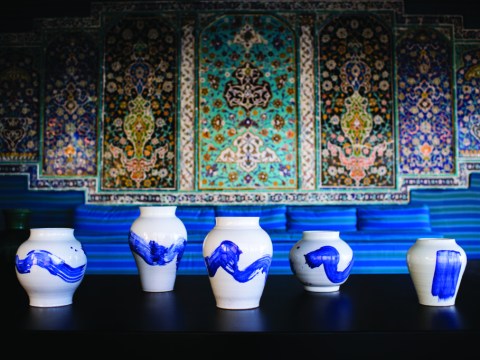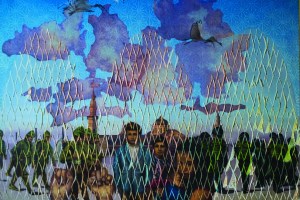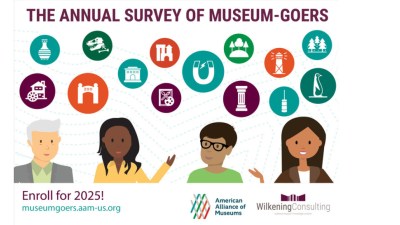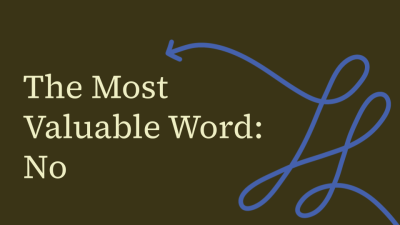
Hawai’i’s Shangri La Museum of Islamic Art, Culture & Design took a community-focused approach with its “8×8” exhibition.
This article originally appeared in Museum magazine’s November/December 2024 issue, a benefit of AAM membership.
The Shangri La Museum of Islamic Art, Culture & Design—a center of the Doris Duke Foundation in Honolulu, Hawai´i—is located within the ‘ili (subdivision) of Kapahulu in the ahupua‘a (land division) of Waikīkī in the moku (district) of Kona on the mokupuni (island) of O‘ahu in the pae´āina (archipelago) of Hawai´i. Shangri La was constructed between 1935 and 1937 by American philanthropist Doris Duke (1912–1993), who was inspired by her extensive travels through North Africa and Western, Central, South, and Southeast Asia. As part of her desire to promote the study and understanding of the art and cultures she experienced during her travels, Duke directed in her will that Shangri La be “available to scholars, students, and others interested in the furtherance and preservation of Islamic art and make the premises open to the public.”
Since opening to the public in 2002, Shangri La has faced challenges related to access, and it has sometimes been perceived as an exclusive space, both physically and conceptually. Many Hawai´i residents have only experienced Shangri La from the outside, as it is visible from the ocean below. Due to its location in a residential neighborhood, a conditional use permit limits the number of people who can access Shangri La to approximately 14,000 tour visitors per year. Shangri La’s core ethos of promoting the learning and understanding of Islamic art and culture has also, at times, been a limiting factor for those with generalized views of Islamic art.
Like many museums, Shangri La staff wanted to improve its relevance and service in the local community. Shangri La sought to expand past the center’s original mission, which seemed both needed and inclusive for South West Asian and North African (SWANA) communities, but could also be perceived as exceptionally exclusionary for Hawai´i residents and Kānaka Maoli (Native Hawaiian) communities.
For the past four years, Shangri La has featured a locally centered exhibition series known as “8×8” to address these challenges. The result was a physical and online platform that transformed not only how artists and the Hawai´i community engaged with the museum and its collection but also spotlighted how institutions like Shangri La should prioritize engagement with the communities in which they exist, create space for addressing complex histories, and embrace a change mindset.
A Focus on Visual and Performing Artists
Past Shangri La programming encouraged moments of dialogue with Hawai´i’s history and arts community, often bringing in local creatives to connect with its residency participants who came from outside of Hawai´i. However, Hawai´i’s arts community was not given a dedicated platform at Shangri La until the development of the “8×8” exhibition series in 2020, which has run for the four-year period 2021–2024. The idea for “8×8” (which was a play on Hawai´i’s 808 area code) came from Shangri La staff who wanted to exhibit the works of artists in Hawai´i and offer them experience working with a museum.
For “8×8,” Shangri La’s curatorial team invited eight visual artists and eight performing artists each year from 2021–2024 to create and show their work at the museum. One visual artist and one performing artist were assigned to each one of the Shangri La galleries to create artwork in response to the annual connecting theme, which were Place (2021), Connection (2022), Continuum (2023), and Source (2024). Artists received the same unrestricted stipend to cover the cost of creating their work, while Shangri La covered the cost to document the installed artwork and performances through professional photography and video.
Each year, visual and performing artist cohorts participated in a Zoom call to learn about each other’s work and their assigned spaces at Shangri La. However, collaboration was not a requirement of the exhibition. From painters and glass artists to classically trained musicians and a youth breakdancing collective, Shangri La’s invitations to artists working in Hawai´i yielded a breadth of artistic output and interpretation of Shangri La. Each of the 64 artists that were part of the “8×8” series brought with them their own community, many of whom had never been to Shangri La before. This engagement also furthered awareness of Pacific connections to SWANA cultures, global history, and the arts.
“Getting down as a part of the ‘8×8’ exhibition allowed a unique opportunity for Hawai´i’s breaking [breakdancing] to be understood as an expressive vehicle to connect and interpret the histories of the landscapes we are connected to in the present moment,” said Jeff Wong (Bboy Ark), mentor of Keiki Breaks, a youth breakdancing collective in Honolulu. Their work for “8×8: Continuum” drew connections between breakdancing as a form of freedom, artistic expression, and resistance.
According to Janet Kelly and Noa Dettweiler of Hawai´i Potters Guild (HPG), participation in Shangri La’s “8×8: Continuum” exhibition in 2023 profoundly inspired its membership, fostering artistic growth and collaboration. The exhibition also “served as a vehicle for Shangri La’s Artist-in-Residence and seventh-generation Afghan potter, Ustad Abdul Matin Malikzada, to forge a powerful and lasting cultural connection with the guild’s community,” said Kelly and Dettweiler. After “8×8,” Shangri La and HPG also worked together on a series of floral vases inspired by Shangri La’s collection to be used for convenings and events the center hosts throughout the year.

Photograph by Elyse Butler, 2021
The inclusion of contemporary artists, especially performing artists, sparked conversations between Shangri La’s collections, curatorial, and programs staff on how to best accommodate creative imagination with open-air collections stewardship. Shangri La’s internal teams needed to transform exhibition spaces for innovation while also continuing cultural heritage stewardship in the galleries. Artists often left concept planning conversations with a deeper understanding of what it means to care for historic art collections.
The Conversations and Critiques
Artists have often been at the forefront of complex and challenging conversations. Artistic works can help audiences sit with discomfort or grief while creating moments of community nourishment and connection.
The architecture and art at Shangri La make it a site of immense artistic beauty and inspiration. But it can also evoke complicated, and at times conflicting, feelings about museums and the colonial legacies attached to them. Shangri La’s open invitation to the artistic community was meant to uplift artists and share space for artistic creativity and celebration, but the center also was prepared to engage with the critiques and questions about Shangri La, and museums in general, that some artists raised in their work. Staff have used these critiques to help Shangri La become a more valuable and contributing member of the community and create dialogue among visitors.
Poet No’u Revilla explored the complex feelings often attached to museums, posing the following question in her poem Nānā i ke kumu: “How can you be something I need, and something I need protection from?” Hip-hop artist Punahele and poet Brandy Nālani McDougall made clear connections in their spoken word pieces to Kānaka Maoli sovereignty, Hawai´i’s history and the histories of Western and Central Asia, and the longing for the return of land.
“Shangri La fostered a beautiful space for me, as a Kanaka ´Ōiwi “8×8” artist (poet), to learn and immerse myself in the wisdom, peace, and beauty of its extensive Islamic art collection and, commendably, to also reflect on the unsettling implications of how these moving artworks came to be in Hawai´i,” shared McDougall, who is also a scholar, activist, and Hawai´i Poet Laureate 2023–2025. “The experience was transformative for me, both personally and creatively, as it led me toward deeper understandings of collective struggle, liberation, and solidarity as well as the ways that Hawai´i remains interconnected with other countries in the world. Much of my poetry now frames Hawai´i in terms of its internationality, and I have Shangri La to mahalo for that.”

Photograph by Elyse Butler, 2020
Artistic responses centered on land restoration extended to broader sustainability topics. Visual artist Brandon Ng’s Da Wretched of Da Earth explored reassertions of indigeneity through a two-part living installation that challenged the manicured landscapes of introduced and invasive plants at Shangri La. The connections made between Ng; Hui Kū Maoli Ola, a local native plant nursery; and Shangri La’s grounds staff resulted in ongoing efforts to reintroduce native plants across the campus.
After four years of working to institutionalize commitments to Hawai´i’s artistic community, “8×8” as an ethos and exhibition is ready to evolve into something deeper. Islamic art and culture are world heritage, and Hawai´i-based conversations are globally relevant. The “8×8” series not only expanded how Shangri La engaged local artists exploring all facets of Hawai´i but also allowed the institution to receive critiques through artistic expression and deepen communication with our community in the process.
“8×8” reaffirmed the need for Shangri La to deepen its impact in and commitments to the Hawai´i community outside of an annual exhibition. Shangri La seeks to continue these commitments through integrated programming that provides visibility and space for Hawai´i residents and Native Hawaiian voices in larger programs like its residency program and convenings of global communities in dialogue.
Shangri La extends its immense gratitude to the 64 “8×8” artists and their collaborators who have helped the center grow over these past four years and to the creative teams that have helped tell these distinct and innovative stories.
Sidebar: Digital Content
Digital accessibility was at the forefront of the “8×8” exhibition design, which allowed artists and their networks to share their work well past the physical run of their exhibitions. This strategy also helped circumvent the challenges of physically accessing Shangri La’s campus and heightened access limitations related to COVID-19.
Shangri La partnered with NMG Network, working with award-winning filmmaker Gerard Elmore, to create high-quality video recordings of performances in the “8×8” exhibition. Elmore’s team collaborated with Shangri La’s curatorial creative team to produce 32 performance videos, which are available on Shangri La’s YouTube channel.
Most important, the Shangri La and NMG teams collaborated with the performing artists to fully realize their vision in transferring an in-person performance to a video format. These videos capture each performance’s sense of wonder while highlighting new ways to experience Shangri La’s space and historic collections. This was integral to “8×8,” since performing artists would not be able to perform their pieces in front of a live audience in the galleries they were assigned due to various capacity limitations. All performances were experienced as video content.
Also, each year, documentary photographer Elyse Butler documented the performance and visual artwork installed in Shangri La’s galleries. Through her own artistry, Butler provided high-impact visual storytelling, creatively capturing the essence and power of each artist’s work and its dialogue within the Shangri La space.
Digital content is also evergreen, helping both the institution and artists tell their stories far past the exhibition timeline. Filmmaker ´Āina Paikai included his short film for “8×8,” OUTSIDE/IN, as part of the July 2023 HŌ´EA screening for Kānaka Maoli filmmakers during the monthlong celebration of Lā Ho´iho´i Ea (Sovereignty Restoration Day). All of Shangri La’s “8×8” exhibitions remain available on its website and YouTube channel.








Comments